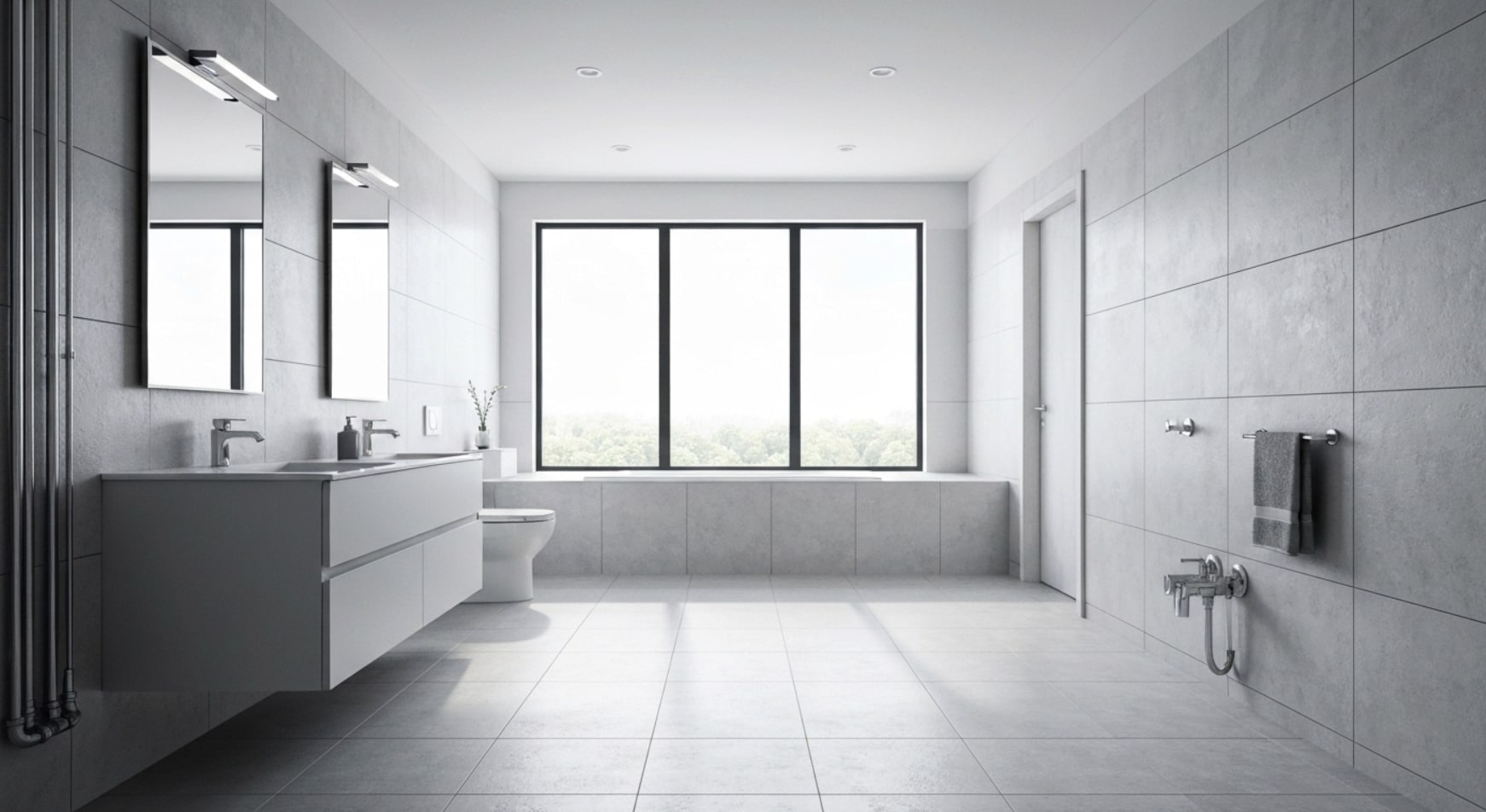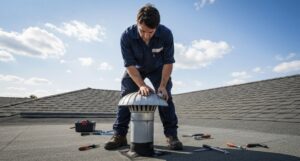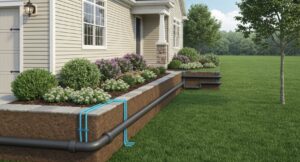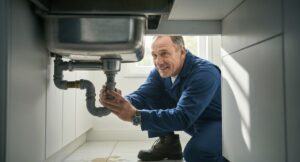Plumbing problems have a knack for showing up at the worst possible times. A small, unnoticed leak can quickly lead to significant water damage, while a slow drain can escalate into a major backup. The good news is that most of these emergencies are preventable. By establishing a consistent plumbing maintenance schedule, you can catch minor issues before they become expensive plumbing problems. This proactive approach of preventive maintenance not only saves you money but also ensures your home’s plumbing system runs efficiently year-round.
Your Ultimate Plumbing Maintenance Schedule: Monthly, Quarterly, and Annual Essentials
A plumbing maintenance schedule helps you avoid unexpected breakdowns by organizing tasks into monthly, quarterly, and annual checks. This approach ensures no part of your system is missed and keeps maintenance consistent. A checklist lets you track each task, protecting your home and giving you peace of mind. Here are the essential tasks for each timeframe.
1. Monthly: Check for Leaks in Pipes, Faucets, and Toilets
One of the most important monthly tasks is to perform a visual inspection for leaks. Take a few minutes to look under every sink, around the base of your toilets, and along any visible pipes in your basement or utility closets. Even a slow drip can waste a surprising amount of water and lead to mold growth or water damage over time.
Don’t forget to check your toilet for silent leaks. A common cause of running toilets is a worn-out flapper, which allows water to constantly seep from the tank into the bowl. This is a frequent source of plumbing problems that can significantly increase your water bill if left unaddressed. Addressing these small issues is a key part of preventive maintenance.
Making this simple check a part of your routine maintenance can save you from major headaches. Catching a leak early is far easier and cheaper than dealing with the consequences of a burst pipe or a damaged floor. It’s a small investment of time for a big return on your home’s health.
2. Monthly: Inspect for Low Water Pressure and Slow Drains
Each month, pay attention to how your water is flowing. Turn on your faucets and showerheads to check for a strong, consistent stream. If you notice weak or sputtering water pressure, it could be a sign of a hidden leak, a blockage in the pipes, or mineral buildup in the fixtures.
Similarly, observe how quickly water goes down your drains. Are your sinks, showers, or tubs draining slower than usual? Slow drainage is an early warning sign of a developing clog. Ignoring it can lead to complete blockages and messy backups, creating significant plumbing problems.
This simple inspection is a core part of regular maintenance. By addressing low pressure or slow drains promptly, you can often prevent the issue from worsening. This proactive step in your plumbing maintenance routine helps keep your entire plumbing system operating smoothly and efficiently.
3. Monthly: Clean Faucet Aerators and Showerheads
Have you ever noticed your faucet spraying water in odd directions or your shower losing its power? This is often caused by mineral buildup. Over time, calcium and other minerals from your water supply can clog the small holes in your faucet aerators and showerheads, restricting water flow.
Cleaning these fixtures is a simple but effective routine maintenance task. You can usually unscrew the aerator or showerhead by hand. For a thorough cleaning, soak the parts in a bowl of white vinegar for a few hours. The vinegar will dissolve the mineral deposits without harsh chemicals.
After soaking, use a small brush, like an old toothbrush, to gently scrub away any remaining residue. Rinse the parts with water, reattach them, and enjoy the restored water flow. Adding this task to your monthly plumbing maintenance checklist is a great preventive maintenance measure to keep your fixtures working like new.
4. Quarterly: Test Water Heater Function and Flush Sediment
Your water heater works hard every day, and quarterly maintenance is key to its longevity and efficiency. A primary cause of water heater failure is sediment buildup. Minerals from the water settle at the bottom of the tank, which can reduce efficiency, cause strange noises, and lead to corrosion. Flushing the tank quarterly or semi-annually helps remove this sediment.
Another critical check is testing the temperature and pressure relief (T&P) valve. This safety device is designed to release pressure if it gets too high inside the tank. To test it, gently lift the lever. You should hear a gurgling sound and see a small amount of water discharge from the pipe. If nothing happens, the valve may be faulty and needs replacement.
This task is a crucial part of your preventive maintenance plumbing maintenance checklist. Regular checks ensure your water heater operates safely and efficiently.
| Water Heater Check | How to Perform It |
|---|---|
| Test T&P Valve | Gently lift the lever. Water should flow from the discharge pipe. If not, the valve may need to be replaced. |
| Check for Leaks | Inspect the area around the base of the water heater for any signs of pooling water or rust stains. |
| Flush Sediment (Annually) | Connect a hose to the drain valve, run it to a floor drain, and open the valve to flush out sediment. |
| Inspect Anode Rod (Annually) | Check the anode rod for corrosion. If it’s heavily worn, replacing it can extend the life of your tank. |
5. Quarterly: Examine Visible Pipes for Corrosion or Damage
Every few months, take a closer look at the exposed pipes in your home, particularly in basements, crawl spaces, and under sinks. You are looking for any signs of corrosion, which can appear as discoloration, rust spots, or flaking on the pipe’s surface. Corrosion weakens the pipe and is a common precursor to leaks.
Pay special attention to the pipe joints and fittings, as these are often the first places where problems develop. Also, look for any warping, dents, or visible damage that could compromise the integrity of your plumbing system. Early detection is a cornerstone of effective preventive maintenance.
Addressing corrosion or damage early can prevent it from escalating into major plumbing problems, such as a burst pipe. This part of your regular maintenance routine is simple but can save you from costly water damage and emergency repairs down the line.
6. Quarterly: Check Toilet Components and Replace Worn Parts
A running toilet is more than just an annoying sound; it’s a major source of water waste. Every quarter, take the lid off your toilet tank and inspect the internal components. The most common culprit for a running toilet is a worn-out flapper, the rubber seal at the bottom of the tank. If it’s warped or deteriorated, it won’t create a tight seal, causing constant leaks.
Also, check the fill valve to ensure it’s functioning correctly and stops filling the tank at the proper water level. A malfunctioning fill valve can cause the tank to overfill or run continuously, leading to more plumbing problems. These parts are inexpensive and relatively easy to replace.
This simple check is a vital part of your routine maintenance. By adding it to your plumbing maintenance checklist, you practice good preventive maintenance, save a significant amount of water, and lower your utility bills. It’s a small effort that makes a big impact.
7. Annually: Schedule Professional Plumbing Inspection
While DIY checks are great for ongoing care, nothing replaces the expertise of a licensed plumber. Scheduling a comprehensive professional inspection at least once a year is one of the most important tasks you can do for your home. A professional has the tools and experience to spot hidden issues that you might miss.
During an annual inspection, a plumber can perform more advanced checks, such as testing your water pressure to ensure it’s within a safe range. Excessively high pressure can put stress on your entire system, leading to leaks and premature failure of fixtures and appliances. This is a critical part of preventive maintenance.
A professional can also identify early signs of pipe degradation, check for hidden leaks using specialized equipment, and ensure your system is up to code. Think of it as a yearly physical for your plumbing. This regular maintenance provides peace of mind and helps you create a long-term plumbing maintenance checklist for future needs.
8. Annually: Inspect Sewer and Drain Lines for Blockages
An annual inspection of your main sewer and drain lines is essential for preventing catastrophic backups. Over time, these lines can become clogged with grease, debris, or even invasive tree roots. Often, the first signs of trouble are subtle, like gurgling noises from your toilets or multiple slow drains in the house.
If you suspect a problem, it’s best to call a professional. They can use a video pipe inspection camera to see inside your sewer line and accurately diagnose the issue without any guesswork. This allows them to identify the exact location and cause of a blockage, whether it’s a simple clog or something more serious like a collapsed pipe.
Ignoring these warning signs can lead to raw sewage backing up into your home, a costly and unsanitary disaster. Making a professional sewer line check part of your annual routine maintenance is a smart move that can save you from one of the worst possible plumbing problems.
9. Annually: Insulate Exposed Pipes for Winter Protection
As winter approaches, preparing your plumbing system for freezing temperatures is a critical annual task. Water expands when it freezes, and this expansion can exert enough pressure to crack or burst a pipe. Insulating any exposed pipes in unheated areas like basements, crawl spaces, and garages is your first line of defense.
You can find pre-slit foam pipe sleeves at any hardware store. They are inexpensive, easy to install, and provide excellent protection. Simply cut the foam to the length you need and slip it over the pipe. For outdoor faucets, disconnect and store your garden hoses and cover the spigots with an insulated faucet protector.
This act of preventive maintenance is one of the most effective ways to avoid the headache and expense of a frozen pipe. Taking an hour or two in the fall to perform this regular maintenance can save you from thousands of dollars in water damage and repair costs, making it an essential part of your plumbing maintenance schedule.
Your Go-To Team for Every Plumbing Emergency—Target Plumbers
Even with the most diligent plumbing maintenance schedule, unexpected issues can still arise. When they do, you need a reliable team you can count on to respond quickly and effectively. Here at Target Plumbers, we understand the stress that plumbing problems can cause, and we’re dedicated to providing fast and professional solutions to get your home back to normal. Whether it’s a sudden leak, a stubborn clog, or a water heater failure, our experienced technicians are ready to help.
Don’t wait for a small issue to become a major disaster. From routine inspections that keep your plumbing system in top shape to emergency repairs when you need them most, we’re your partners in maintaining a safe and efficient home. Contact Target Plumbers today for all your plumbing needs and experience the peace of mind that comes with knowing you’re in expert hands.
Conclusion
Creating a plumbing maintenance schedule is essential for ensuring the longevity and efficiency of your home’s plumbing system. By adhering to a structured plan—monthly checks for leaks, quarterly inspections of water heaters, and annual professional assessments—you can prevent minor issues from escalating into costly repairs. Additionally, incorporating preventive measures like using drain screens and monitoring water usage will further safeguard your plumbing. Remember, a little maintenance goes a long way in preserving your plumbing infrastructure.
We outlined the full schedule in our main article on Plumbing Maintenance Tips That Every Homeowner Should Know—this post breaks it down even further.
Frequently Asked Questions
How often should I perform plumbing maintenance at home?
It’s best to break down plumbing maintenance into frequencies. Perform simple routine maintenance tasks like checking for leaks monthly. More involved preventive maintenance, like testing your water heater, should be done quarterly. Finally, schedule a comprehensive professional inspection of your entire plumbing system annually to catch any hidden issues.
What are the most important tasks to include in a plumbing maintenance schedule?
Your plumbing maintenance schedule should prioritize checking for leaks, inspecting for slow drains and low water pressure, cleaning faucet aerators, and testing the water heater’s pressure relief valve. An annual professional inspection and a sewer line check are also crucial tasks to include in your preventative maintenance checklist.
How do I create a plumbing maintenance schedule for my facility?
Start by listing all plumbing components in your facility. Group maintenance tasks by frequency: monthly (leak checks, drain tests), quarterly (pipe inspections, valve tests), and annual (professional inspections, water heater flushing). This structured approach to regular maintenance ensures all preventive maintenance is covered consistently and efficiently.






